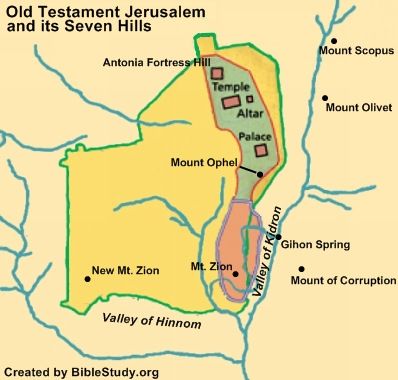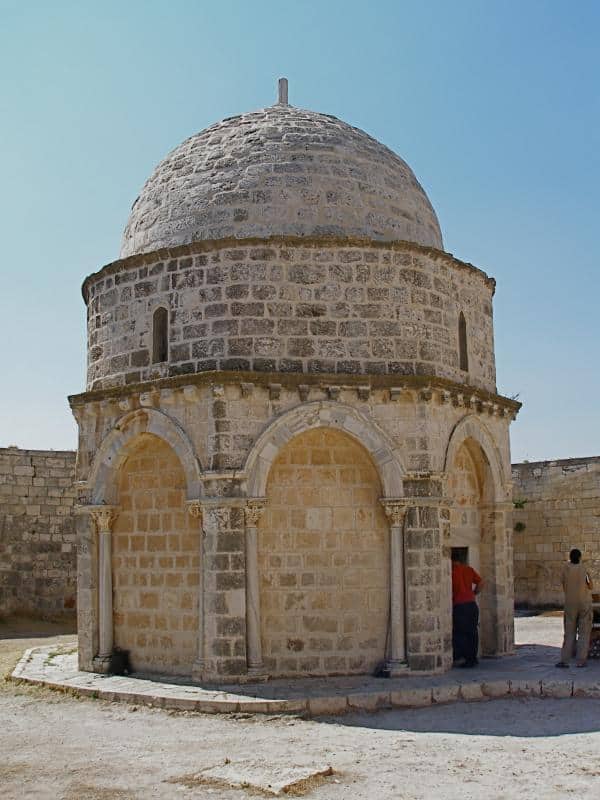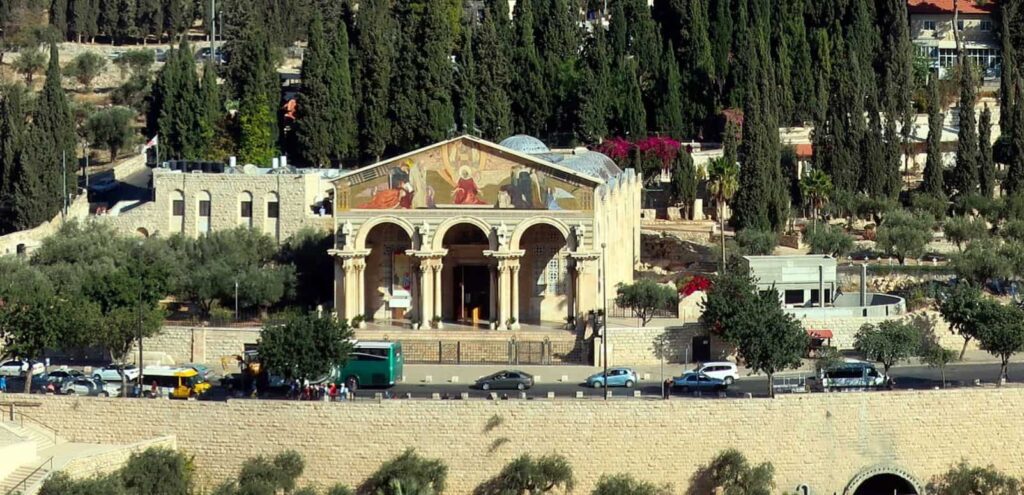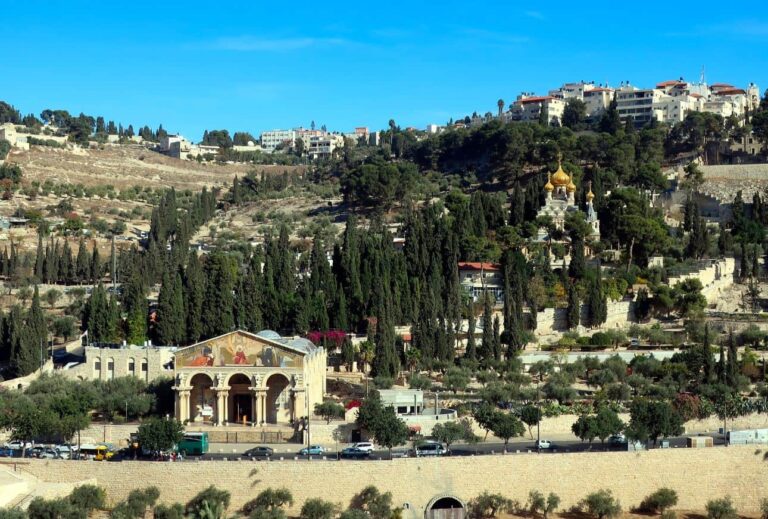Share with friends:
The Mount of Olives in East Jerusalem gives you more than just a fantastic aerial snapshot of the old city of Jerusalem. It is an important geographical landmark because of its RICH history and end-time implications for Judaism, Islam, and Christianity.
The Mount of Olives derives its name from the olive trees which grew in abundance on its slopes, down to the Kidron valley.
It is also called Mount Olivet, and elsewhere, Har ha-Zetim by the Jews, and Jabal at-Ṭūr by the Arabs. It is also called the Mount of Anointment because of the anointment oil derived from its olive trees. The oil was used to anoint high priests and kings in Biblical times.
The Mount of Olives is actually one of the 3 hills located in East Jerusalem, from where one can have a clear view of Temple Mount, just across the Kidron Valley.
There are a total of 7 hills in the whole of Jerusalem.


Of course, the Mount of Olives conjures up a lot of memories, intrigue, and end-time prophesies. Jewish mythology even suggests that the dove sent by Noah from the ark actually plucked an olive leaf from a tree on the Mount of Olives!
Well, that is a story for another time.
A journey through time!


The Mount of Olive is mentioned a few times in the Old Testament, and over 10 times in the New Testament. Likewise, in the 21st century, the Mount of Olives is in the news every other day!
Let us go through its long history starting with the Old Testament up until the 21st century, to see what has changed.
1. King David and the ascent of the Mount of Olives
King David happens to be the first person to be associated with the Mount of Olives.
His journey to the top of the Mount of Olives was a result of his failed relationship with his handsome and 3rd son Absalom.
King David was forced to flee Jerusalem to the East of the city when he was told Absalom had organized an army and was placing the city under siege.
It is during this escapade that he found himself walking up and around the mountain.
But David went up the ascent of the Mount of Olives, weeping as he went, dbarefoot and ewith his head covered. And all the people who were with him covered their heads, and they went up, fweeping as they went.
Biblia
Of course, Absalom’s transgression did not go as planned because he was killed soon after by Joab as he attempted to flee from David’s army.
2. King Solomon and the abomination
Solomon replaced David as King and became the wisest man alive. In his old age, however, his entanglement with the Mount of Olives bordered an abomination.
But first, he was reputed for constructing the First Temple in Jerusalem, in the Temple Mount around 957 BCE. It was meant to be the final resting place for the wandering Ark of the Covenant.
King Solomon was also known for marrying many women, including foreign women, a thing he had been warned not to do by God.
In his attempt to please some of his foreign women, he built idols for them on top of the Mount of Olives.
7 Then Solomon built a high place for cChemosh the abomination of Moab, and for dMolech the abomination of the Ammonites, on the mountain east of Jerusalem.
God punished Solomon by stirring rebellion in the Kingdom soon after his death.
3. Ezekiel and the end of days prophecy
Finally, in the Old Testament, the mountain is used in reference to the end of days prophecy.
In one of his visions, prophet Ezekiel sees the Lord’s glory leave Jerusalem and rests on Mount of Olives. (Ezekiel 11:23).
23 And the glory of the Lord went up from the midst of the city and fstood on the mountain that is on the east side of the city.
4. Jesus and the Mountain of Olives


In the New Testament, Jesus is known to have visited the Mount of Olives multiple times. Besides, he prayed frequently in the Garden of Gethsemane, on the slopes of the mountain.
His journeys happened before and after his earthly life!
And in the day time he was teaching in the temple; and at night he went out, and abode in the mount that is called the mount of Olives.
King James Bible Online
The following include some of the moments he visited the mountain:
- Jesus often visited Mary, Martha, and Lazarus in Bethany which is located on the eastern slopes of the hill.
- He visited the hill in the triumphant entry to Jerusalem, otherwise known as Palm Sunday.
- Jesus answered questions about the end times and his final return when he was at the Mount of Olives.
- His other visit was on the night he was betrayed by Judas.
- His final visit was in Bethany when he blessed the disciples before ascending up into the Heavens.
- Following his ascension, two angels told the disciples that Jesus would return to the Mount of Olives during the end times.
5. Judaism and the Mount of Olives
The Mount of Olives became particularly important to the Jews during and following the destruction of the 2nd Temple by the Romans in 70 BCE.
Here, they celebrated the Sukkot, or the Feast of the Tabernacle, the Hoshanna Raba, and worshiped God on the Sabbath. Since the altitude of the Mount was higher than that of Temple Mount, pilgrims were also able to view the Temple site from above.
Secondly, the slopes of Mount of Olives became a popular burial ground in preparation for Jesus’ second coming. The cemetery took real shape after Jerusalem was turned into the capital city during King David’s era.


Jerusalem. Image by AlbertoLuccaroni from Pixabay)
It is believed to be the spot where Jesus will arrive first and resurrect all the dead. He will thereafter resurrect the rest of the dead the world over.
It so happens that 70,000 to 150,000 Jews have been buried on this spot for over 3,000 years. Many more desire to be buried here in the 21st century.
Anyone who is buried on the slopes of the hill does not have to go through the rituals of atonement like those buried elsewhere.
6. Islam and the At-Tur


The Mount of Olives happens to be located in what was previously part of the Jordanian and Palestinian West Bank. Israel took control of the area (East Jerusalem) following the Six-Day war of 1967.
The Palestinians still consider the city their own and are actually in charge of its day-to-day affairs.
One center of attraction in East Jerusalem is definitely At-Tur.
At-Tur is a district in Mount of Olives that is inhabited by majorly Palestinian Muslims and Jews, and a small number of Christians. At-Tur is Arabic for The Mount.
It hosts the Ascension Chapel (also called the Mosque of Ascension). Jews, Christians, and Muslims believe Jesus stood on this site before ascending to heaven. The Muslims though believe that Issa (Jesus), did not die but was taken alive to the heavens.
The chapel/shrine is located inside a courtyard of a 12-century mosque and contains a slab with Jesus’ right footprint. The slab containing his left foot was relocated to the Temple Mount, just across the Kidron Valley.
All religions in the area and from around the world worship freely in these sites.
Besides the Ascension chapel, other installations in the At-Tur district include the Auguste Viktoria Hospital, the Paternoster Church, the Seven Arches Hotel, a church, a monastery, and a mosque.
The district was for a long time under the jurisdiction of Roman, Byzantine, and Muslim rule, not until 1967 when Israel annexed it from Jordanian authority.
The Mount of Olives and Christians
The mountain of Olives perhaps hosts one of the biggest concentrations of Christian sites anywhere in the world. These Holy shrines and churches are adorned with varying levels of decorations to reflect varying beliefs.


Just a list of churches in the Mount of Olive:
- The Chapel of Ascension
- Church of Mary Magdalene
- Russian Orthodox Convent and Church of the Ascension
- Augusta Victoria Lutheran Hospital, Church and Tower
- Church of All Nations (Basilica of the Agony)
- Dominus Flevit (The Lord Wept)
- Augusta Victoria Compound
- Church of St Peter in Gallicantu
- Tomb of Mary
- The garden and grotto of Gethsemane
The Mount of Olives and the End Times!
The Mount of Olives is cited by the Bible as the place where Jesus will set foot when he descends from Heaven.
Zechariah writes,
And his feet shall stand in that day upon the mount of Olives, which is before Jerusalem on the east, and the mount of Olives shall cleave in the midst thereof toward the east and toward the west, and there shall be a very great valley…
Technically, this is where Jesus will begin resurrecting the dead and end the anarchy in the world. Then he will set up His Kingdom to stretch for 1,000 years.


0 Comments